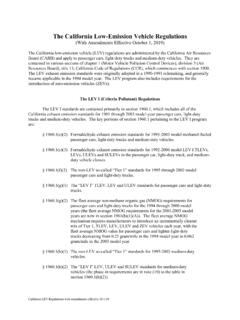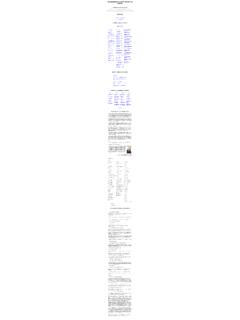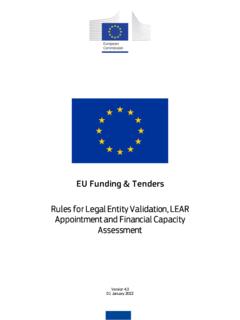Transcription of LEV III and Tier 3 Exhaust Emission Control Technologies ...
1 lev iii and Tier 3 exhaust emission control technologies for Light-Duty Gasoline Vehicles April 2013. Manufacturers of Emission Controls Association 2020 14th Street North * Suite 220 * Arlington, VA 22201. Table of Contents Figures and Tables ..2. Executive Summary ..3. Introduction ..6. Technology Forcing Exhaust Emission Regulations ..7. California's lev iii and Proposed Tier 3 Emission Standards ..11. Gasoline Emission Control Technology ..15. Close-Coupled Converters ..18. High Cell Density Substrates ..21. Advanced Three-Way Catalysts ..28. Impact of Gasoline Sulfur on Three-Way Catalysts ..34. Gasoline Particulate Filters ..36. MECA Large Light-Duty Truck Test Program ..37. MECA/Environment Canada GDI-GPF Test Program ..38. Conclusions ..40. References ..41. April 2013. 1. List of Figures Figure 1: Fleet average Emission limits for NMOG and NOx in LEV I and II.
2 9. Figure 2: Fleet average NMOg + NOx Emission limits under lev iii and Tier 3 ..12. Figure 3: Three-way catalytic converter with ceramic substrates ..16. Figure 4: Three-way catalytic converter with metallic substrates ..17. Figure 5: Exhaust system with close-coupled converters ..20. Figure 6: Exhaust manifold designed for thermal management ..20. Figure 7: Relative geometric surface area and bulk density of ceramic substrates ..22. Figure 8: NMHC FTP emissions for substrates with varying cell density and wall thickness ..24. Figure 9: NOx FTP emissions for substrates with varying cell density and wall thickness ..24. Figure 10: FTP NMHC emissions vs. substrate geometric surface Figure 11: Accumulated FTP HC emissions for a three-way catalyst coated on high cell density metal substrates.
3 27. Figure 12: Accumulated FTP NOx emissions for a three-way catalyst coated on high cell density metal substrates ..28. Figure 13: Impact of advanced catalyst formulations on NOx FTP emissions from a liter, V8 test vehicle equipped with close-coupled + underfloor converters ..31. Figure 14: Impact of catalyst coating architecture on total hydrocarbon and NOx performance of a Pd/Rh three-way catalyst ..31. Figure 15: FTP NOx performance for PZEV vehicle tested at two gasoline sulfur levels ..35. Figure 16: Particle number emissions from GDI and PFI vehicles over FTP test cycle ..39. Figure 17: Particle number emissions from GDI and PFI vehicles over US06 test List of Tables Table 1: California LEV II 120,000 mile tailpipe Emission limits ..10. Table 2: EPA Tier 2 120,000 mile tailpipe Emission limits.
4 11. Table 3. California lev iii 150,000 mile tailpipe Emission limits ..13. Table 4: Ceramic substrate properties for standard and high cell density products ..23. Table 5: Metallic substrate properties for high cell density products ..26. April 2013. 2. Executive Summary In response to continued public health concerns associated with ground level ozone and toxic hydrocarbon components of vehicle Exhaust , the Environmental Protection Agency and California Air Resources Board established the Tier 2 and LEV II Emission regulations, respectively, for light-duty vehicles in the late 1990s that began implementation starting with the 2004 model year. The Tier 2 and LEV II programs remain as the toughest light-duty vehicle standards in the world with the LEV II program being followed by lev iii in 2015.
5 The EPA has proposed the next round of light-duty standards known as Tier 3 that will tighten light- duty tailpipe standards beyond Tier 2 starting in 2017 and are largely harmonized with lev iii . Emission standards. The Tier 2/LEV II regulatory programs established a single set of fuel neutral, vehicle Emission certification categories that auto manufacturers can select from for the broad weight range of light-duty cars and trucks that make-up the passenger vehicle segment (up to 8500 lbs. GVW for all light-duty cars and trucks, and up to 10,000 lbs. GVW for passenger carrying vehicles). The Tier 2 and LEV II requirement established significantly lower levels of hydrocarbon and NOx Emission levels with extended durability requirements ( , 120,000. miles) compared to the previous Emission regulations (Tier 1/LEV I) for light-duty cars and trucks.
6 Manufacturers must comply with not only the selected certification category Emission limits but also meet fleet average Emission limits: an oxides of nitrogen (NOx) Emission fleet average in the case of Tier 2 and a non-methane organic gas (NMOG) Emission fleet average in the case of LEV II. As part of these light-duty rulemaking efforts, both California and the EPA. also established limits on gasoline fuel sulfur levels, a known catalyst deactivation agent. California's 15 ppm average gasoline sulfur level requirement began in 2004 and EPA's 30 ppm average gasoline sulfur level phase-in began in 2005. California requires a gasoline sulfur cap of 20 ppm starting in 2012. In January 2012, California adopted their Advanced Clean Cars program that included tighter criteria pollutant standards for light-duty vehicles as part of their lev iii regulations, greenhouse gas (GHG) standards for model years 2017-2025, and revised zero Emission vehicle (ZEV) requirements.
7 The lev iii requirements impact passenger cars and light-trucks up to 8,500 lbs GVWR, medium-duty passenger vehicles up to 10,000 lbs and medium-duty trucks up to 14,000 lbs GVWR. The standards phase in from 2015 to 2025 and require that a manufacturer's light-duty fleet average meets a combined NMOG + NOx emissions limit of 30. mg/mile (or SULEV) by 2025 with a 150,000 mile durability requirement. The lev iii . standards set tighter PM FTP emissions limits for both diesel and gasoline vehicles of 3 mg/mile by 2017 and 1 mg/mile starting in 2025. The EPA Tier 3 light-duty program proposal is largely harmonized with California's lev iii standards with implementation targeted to start in the 2017 to 2018 timeframe. The Tier 3 proposal does not tighten FTP PM Emission limits beyond the 3 mg/mile level.
8 To achieve the Emission requirements of the Tier 2/LEV II and subsequently lev iii /Tier 3 programs, a systems engineering and optimization effort is required combining advanced engines, advanced engine Control strategies, cleaner fuels with advanced Emission Control Technologies . Interest in high performance Emission systems, along with the interest in lowering April 2013. 3. future light-duty vehicle Emission standards, drove the development of advanced Emission controls during the late 1980s and 1990s. The results of these developments are a number of key Emission Control Technologies that manufacturers have implemented into their fleet for Tier 2/LEV II compliance. Included in these key Technologies are close-coupled converters, high cell density substrates, and advanced three-way catalysts.
9 The maximum performance benefits for each of these advanced Emission Technologies result from combining these Technologies with optimized engine operating strategies and high quality fuels and lubricants that are compatible with these high Emission conversion efficiency components. The most advanced Technologies have already been deployed on millions of vehicles in the fleet to achieve California SULEV and PZEV Emission limits. lev iii and Tier 3 will build on this experience and extend the application of these advanced Exhaust and evaporative Emission Control strategies across the entire fleet of light-duty vehicles to comply with a SULEV fleet average by the 2025 model year. A significant challenge to achieving SULEV Emission limits on the larger vehicles involves reducing cold-start emissions to the lowest possible levels.
10 Close-coupled converters facilitate the fast converter heat-up necessary to significantly reduce emissions within seconds after the engine is started. Engine cold-start strategies aimed at accelerating converter heat-up, including spark retard during engine start and lean air/fuel engine start strategies, are used to complement and enhance the performance of close-coupled converters during the first few critical seconds following engine start. In the future, vehicle manufacturers will need to consider the impacts of GHG reduction strategies together with their efforts to reduce criteria pollutants when complying with California's Advanced Clean Cars program or the federal Tier 3 and GHG. standards. One such strategy may involve engine calibration to maximize combustion efficiency while relying on Exhaust controls to minimize NOx and other criteria pollutants.













